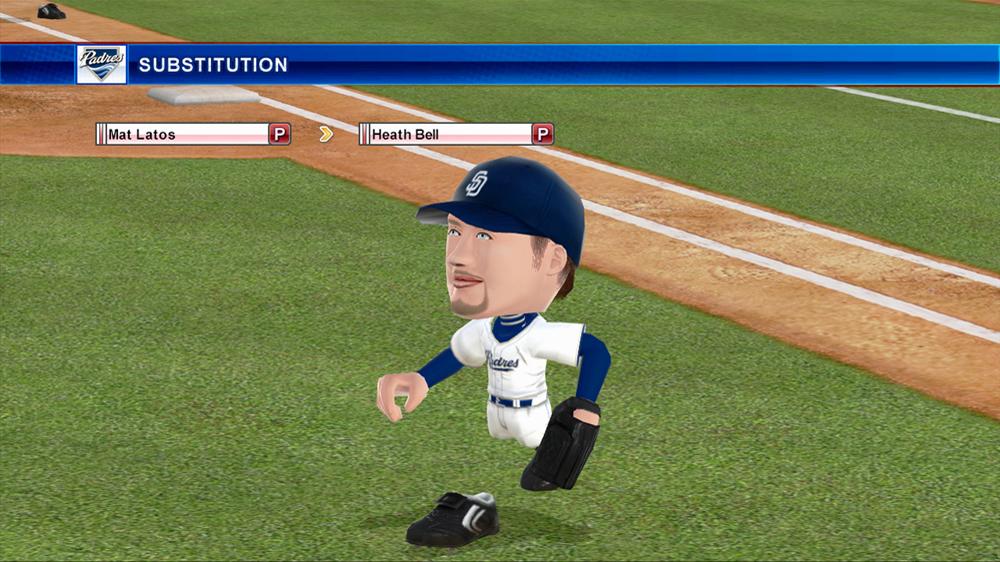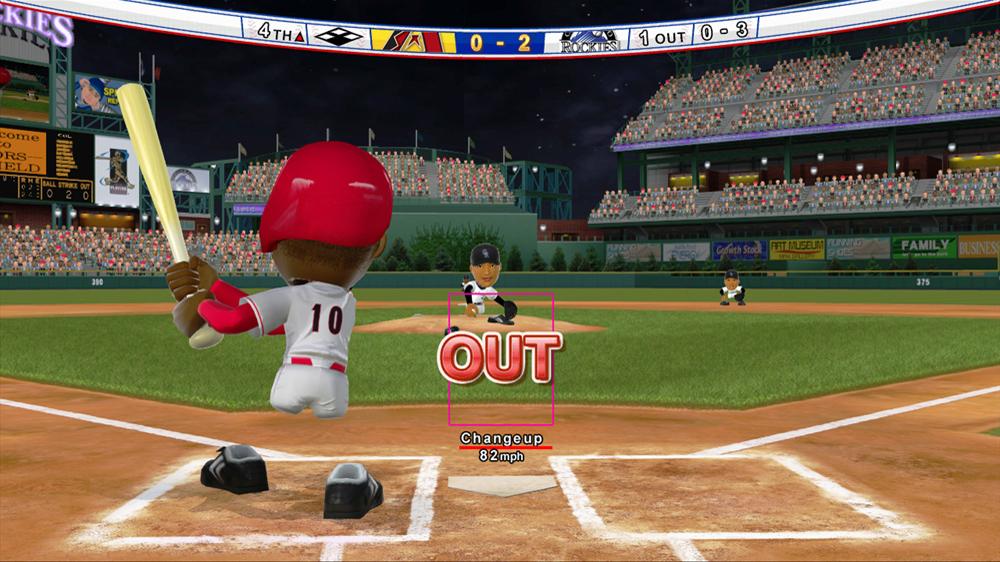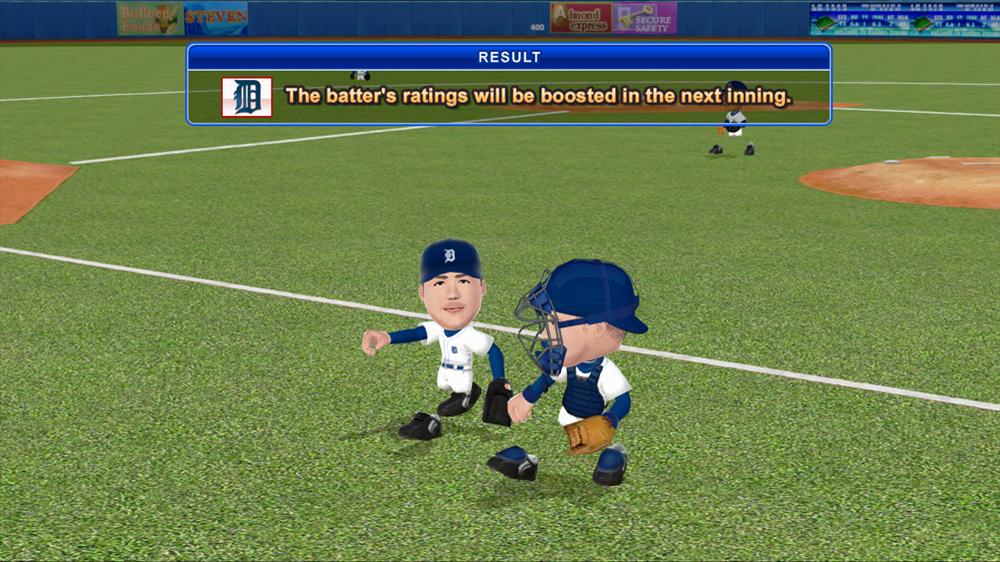

Before each game, every player on the two teams is given a color-coded "form" rating:
Form can have a huge impact on in-game performance, so if a pitcher in your rotation is in top condition, look to get him into the lineup ahead of players who are feeling so-so or subpar. If all your starting pitchers are resting or in poor condition, don't be afraid to pitch two or three hot relievers that day to make it through the game.
Star pitchers are really the only ones you want in your lineup even when they're in poor form. A "below-average" Zack Greinke, for example, will still perform better for Milwaukee than an "excellent" Chris Narveson.
A tired pitcher is a bad pitcher, regardless of his skill level. Elite players may be able to battle through the early signs of fatigue (the "wiping away sweat" or "heavy breathing" animations), but once your hurler's arm starts sagging and throbbing, it's time to call the bullpen.

Note that the CPU will wise up and start anticipating your throws if you follow the exact same sequence repeatedly. Keep the computer guessing by varying your pitch types and pitch locations.
Also look for players who have the "First Ball Hitter" or "Bad Under Pressure" abilities. "First Ball Hitters" will receive a temporary ratings boost until you record the first strike against them. Alternatively, players who are "Bad Under Pressure" will have their ratings drop if they get down to their last strike in the at-bat.

Each batter's strike zone has unique "hot" and "cold" areas. Before each game, go through your opponent's lineup and familiarize yourself with each hitter's hot spots.
During the game, try to locate all your pitches in "neutral" or "cold" regions.
CPU hitters have a tendency to sit on their hot zones. When you wind up, notice where CPU's cursor is sitting and try to pitch around that area.
In addition to numeric attribute ratings, each pitcher has a unique set of abilities that can dynamically alter his ratings depending on the game situation.
A player's active abilities will be colored blue or red. Grey abilities are inactive.
Generally, most blue abilities will benefit the player, though some blue categories like "Fastball MVT" actually indicate that the ability is "average" unless there's an arrow next to it pointing up or down. If you see an "up" arrow next to a blue ability, it indicates your pitcher is good at that ability, while a "down" arrow means he's poor in that area.
Just remember that the colored abilities are the only active ones, as all uncolored abilities have no influence.
In season mode, abilities activate or deactivate as you gain experience points. Using the roster editor, you can manipulate the abilities for every player in the game.

Here is the full list of possible pitcher abilities:
W/RISP -- The acronym stands for "with runners in scoring position." Your pitcher's ratings will receive a slight boost anytime the opposing team has runners on second or third base.
Composure -- Determines how well your pitcher throws when there are runners on base.
VS LHB -- Your pitcher's ratings receive a slight boost against left-handed batters.
Fastball MVT -- The pitcher has good movement on his fastballs.
Pitch Break -- The pitcher has good movement on his breaking balls.
Good Low Pitch -- The pitcher has good control in the lower parts of the strike zone.
Groundball P -- Your pitches are difficult to hit into fly balls.
Fly Ball P -- Your pitches are easy to hit into fly balls.
Weak Closer -- Your pitcher's performance is poor during the later innings.
Strong Closer -- Your pitcher is at his best during the later innings.
Slow Starter -- Your pitcher begins with lowered ratings. His pitch ratings reach their normal levels only after throwing a few dozen pitches.
Strikeout Pitcher -- Your pitcher's ratings receive a small boost whenever he has a two-strike count.
Good Pickoff -- Your pitcher is skilled at picking runners off.
Quick Delivery -- A short wind up makes your pitcher difficult to steal against.
Deceptive --Your pitcher's throwing motion is the same for fastballs and breaking balls.
Good Fielder -- Your pitcher rarely commits throwing errors and is more likely to catch balls batted directly at him.
Wild -- Your pitcher has a tendency to throw "mistake pitches." Low mistake pitches often get past the catcher and hit the backstop.
Poise -- Your pitcher remains calm after giving up a hit.
Hot Head -- Allowing hits causes your pitcher to become increasingly wild.
Lazy -- The pitcher has a tendency to relax against weaker batters.
Unlucky -- The pitcher manages to lose lots of games somehow.
Lucky -- The pitcher manages to win lots of games somehow.
Intimidator -- Your pitcher makes opposing batters nervous.
Strong Will -- Determines the degree to which a player's ratings are affected by his form. A "strong will" allows the player to overcome and play through poor form. A down arrow in this category means the player's ratings will change dramatically depending on his current form.
Recovery -- Your pitcher recovers quickly after pitching a game.
Meatball -- Mistake pitches are less likely to fall in the middle of the plate.
Fat Ball -- Mistake pitches are more likely to land in the middle of the plate.
Gyroball -- The ball spins like a gyroscope, making the ball appear to move faster.
Gamer -- The player pitches "full of fighting spirit."
Pokerface -- Your pitcher does not show fatigue or emotion.
Good Night Game -- Your pitcher excels at night games.
Good Day Game -- Your pitcher excels in afternoon games.
Good Rain Game -- Your pitcher throws well in the rain.
Durability -- Your pitcher is highly resistant to injuries.




 The EASHL Survival Guide
The EASHL Survival Guide NCAA Football Defensive Strategy: Cornerback
NCAA Football Defensive Strategy: Cornerback OS Tip of the Day: Use Your Farm System in the Show
OS Tip of the Day: Use Your Farm System in the Show OS Tip of the Day: Never Waste Time in SSX
OS Tip of the Day: Never Waste Time in SSX OS Tip of the Day: MLB The Show Franchise Farm Systems
OS Tip of the Day: MLB The Show Franchise Farm Systems